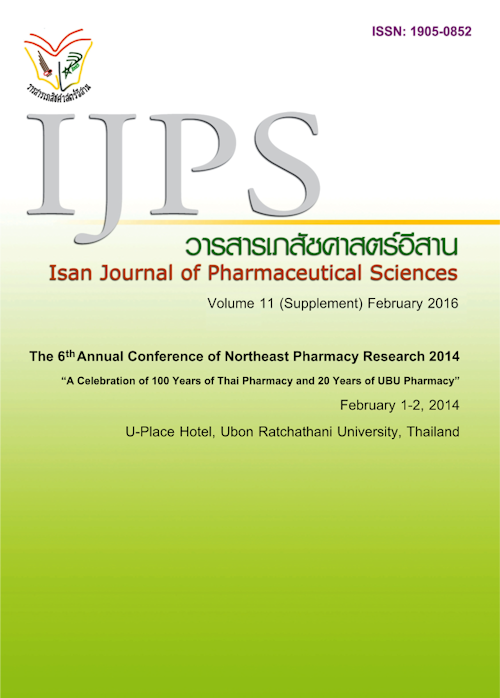Development of Herbal Body Tonic Mixtures
Main Article Content
Abstract
Introduction: Nowadays, people are more attentive to their health. Herbal medicines are getting significant attention in body tonic. Materials and Method: The four herbal formulas were prepared by decoction. The antioxidant activity assays were performed using the DPPH and FRAP assay. The physical and chemical stability were tested including color, odor, sedimentation, taste and pH.The microbiological limit test was conducted using the total aerobic bacteria. Results: There is no significant difference between the four formulated mixtures in antioxidant assays (p>0.05) whereas the formulated mixtures showed significantly higher antioxidant activities when compared to the control formulas (p<0.05).Total aerobic bacteria of all formulas were reached the standard criterion. Conclusion: The formula C of the herbal mixtures was selected for further investigation as herbal tonic preparation.
Article Details
In the case that some parts are used by others The author must Confirm that obtaining permission to use some of the original authors. And must attach evidence That the permission has been included
References
Amom Z, Bahari H, Isemaail S, Ismail NA, Shah ZM, Arsyad MS. Nutritional composition, antioxidant ability and flavonoid content of Tinospora crispa stem. Adv. in Nat. Appl. Sci 2009; 3(1): 88-94.
Ingkaninan K, Temkitthawon P, Chuenchom K, YuyaemT, Thongnoi W. Screening for acetylcholinesterase inhibitory activity in plants used in Thai traditional rejuvenating and neurotonicremedies. J Ethnopharmacol 2003; 89(1): 261- 4.
Jaziri SK, Neffati A, Limem I, Boubaker J, Skandrani I, Sghair MB, et al. Relationship correlation of antioxidant and antiproliferative capacity of Cyperus rotundus product towards K562 erythroleukemia cell. ChemBiol Interact 2009; 181: 85–94.5
Luanchoy S, Tiangkul S. Study of antioxidant of a thaitraditional formula for longevity. [PhD thesis]. Bangkok: Mahidol University; 2008. [in Thai]
Mathew S, Kuttanu G. Immunomodulatory and antitumour activities of Tinospora cordifolia. Fitoterapia 1999; 70: 35-43.
Maturin LJ, Peeler JT. Aerobic plate count. In: Maturin LJ, Peeler JT, editors. Food and drug administration bacteriological analytical manual. 8th ed. Gaithersburg (MD): AOAC International; 2001.
Pakdeechote P, Kukongviriyapan U, KukongviriyapanV. Screening for free radical scavenging activities of extracts from Coccinia grandi and Centella asiatica. Srinagarind Med J 2003; 18(2): 78-84.
Pongpiriyadacha Y, Nuansrithong P, Sirintharawech N. Antioxidant activity and xanthine oxidase inhibitor from Thai medicinal plants used for tonic and longevity. [Sci Tech thesis]. Nakhon Si Thammarat: Rajamangala University of Technology Srivijaya; 2009. [inThai]
Rastogi S, Kulshreshtha DK, Rawat KS. Sterblus asper Lour. (Shakhotaka): A review of its chemical pharmacological and ethnomedicineproperties. evid Based Complement AlternatMed 2006; 3(2): 217–22.
Sittichai N. Thai Journal of Phytopharmacy Vol. 11(1) Jun. 2004. [in Thai] Taepongsorath L.Antioxidant activity of some local vegetables in Mahasarakham province. mahasarakham: mahasarakham university; 2544. [in Thai]
Tangsuksant T. Development of extemporaneous oral rifampin suspensions for pediatric at Mahasarakharm Hospital. [BSc thesis]. Mahasarakharm University; 2007. [in Thai]
Tunsaringkarn T, Soogarun S, Rungsiyothin A, Palasuwan A. Inhibitory activity of Heinz body induction in vitro antioxidant model and tannin concentration of Thai mimosaceous plant extracts. [AHS thesis]. Bangkok: Chulalongkorn University; 2012. [in Thai]
Watcharakupt O. Radical scavenging agent. Nonthaburi: PS printing; 2006. [in Thai]


